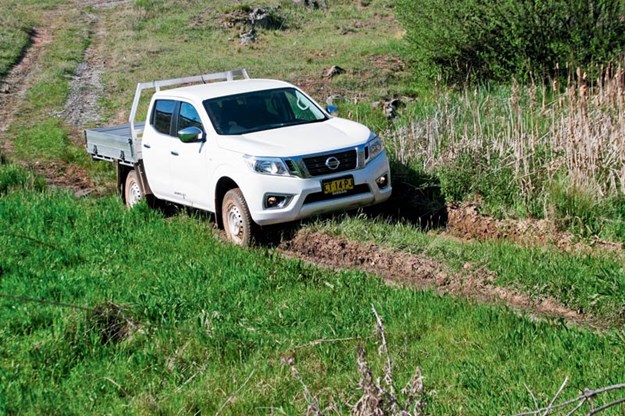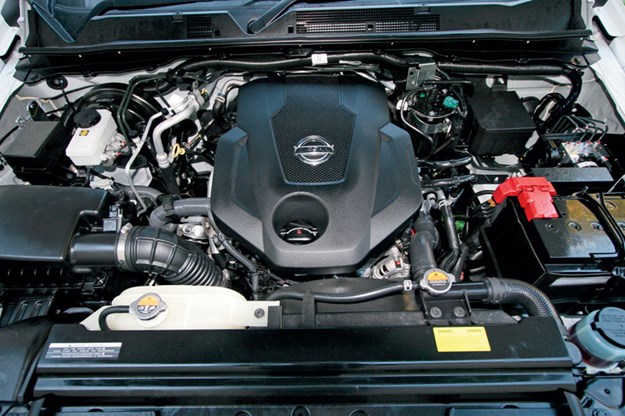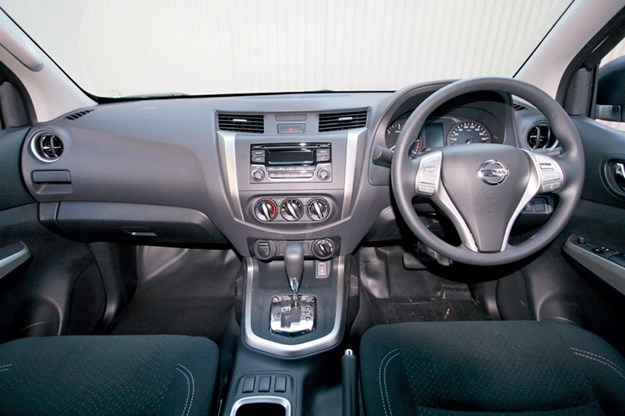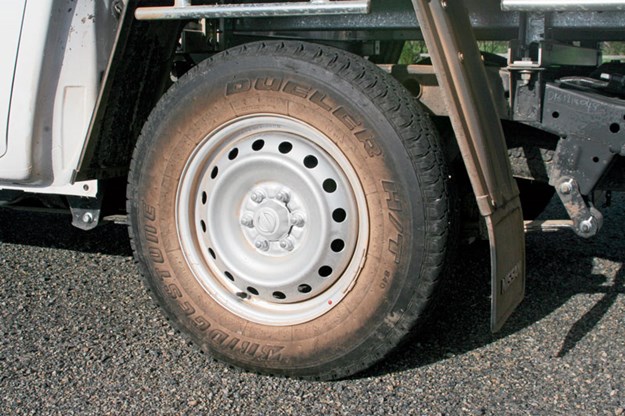Nissan sells a wide array of Navara 4x4 dual-cabs but only one comes with leaf springs rather than coil springs at the rear. Fraser Stronach put it to the test
 |
|
The Nissan Navara RX cab-chassis ute
|
The latest generation Navara, the D23, arrived in Australia with much fanfare in mid-2015. The D23 replaced the very successful, Hilux-challenging D40 that debuted in 2004.
Before that, the D40 replaced the D22 of 1979, which in turn replaced the D21 of 1985.
Before that time, Nissan utes went under the names 720, 620, 520, etc., all the way back to the 120 of 1955. Going back even further, Nissan produced its first light truck in 1938, so it’s not new to this business.
Much of the fanfare with the D23 was that it had coil springs rather than leaf springs at the back of seven out of eight dual-cab models on offer. The coil springs were not only a departure from previous Navaras but went against the common ute practice of using leaf springs on the load-carrying axle.
Coil springs are more associated with passenger cars and comfort, and leaf springs with trucks and load carrying, so a bold move by Nissan even if others, like Land Rover with its Defender ute, have gone down this road before with success.
Perhaps all would have been fine if Nissan hadn’t also decided to chase the heavy load and tow segment of the broader ute market by claiming the same 3,500kg class-leading towing capacity of bigger utes such as the Ford Ranger and the Holden Colorado rather than a more conservative lower tow rating as per the Mitsubishi Triton or Toyota Hilux (automatic).
In practice this didn’t pan out well and, after “owner feedback” through dealers, within a year a ‘Series 2’ model with significant suspension revisions arrived for 2017, only to be updated again with more suspension changes, and a revision of the steering, for the 2018 model. For all that the coil spring Navara is much better sorted now.
While all this has been going on, you have been able buy a Navara 4×4 dual cab with leaf springs at the rear, but in only one specific variant, the RX cab-chassis 4×4 we have here.
 |
|
The RX’s engine claims 120kW of power and 403Nm of torque
|
CLIMB ABOARD
From the outside there’s no mistaking the fact that the RX is a base-spec ute thanks to its steel wheels, lack of sidesteps and its work tray. The leaf spring Navara only comes as a cab-chassis, hence the tray, although it shouldn’t be hard to pick up a factory tub and fit that if you wanted a smarter-looking and more aerodynamically efficient ute. With the optional seven-speed automatic (a six-speed manual is standard) the RX is $41,350 plus on-road costs.
Once inside, the vinyl floors and the basic dashboard (no big touchscreen) confirm that the RX is more work ute than family ute. Still, the vinyl floors have benefits over carpets and the RX’s equipment (see ‘Equipment Check List’) covers all the basics.
Otherwise the RX’s cabin is the same as any Navara dual-cab in as much as it’s among the smaller of the popular dual-cabs (along with Triton and Hilux) but is still roomy and comfortable enough, even if the back seat is a squeeze for three adults. There’s no reach adjustment for the steering wheel either (tilt adjustment only) but the RX still provides a comfortable and roomy driving position. Height adjustment for the driver’s seat is also a nice touch at this price point.
 |
|
It’s among the smaller of the popular dual-cabs but is still roomy
|
ON THE ROAD
Aside from only being available ex-factory as a cab-chassis, the leaf spring Navara’s other single-model limitation is that it only comes with the less powerful of the two 2.3-litre four-cylinder diesels on offer in the wider Navara range.
The RX’s engine claims 120kW of power and 403Nm of torque while the more expensive Navaras get the 140kW/450Nm engine, the difference being in the turbo arrangements. Where the RX gets a relatively simple single turbo, the SL models and above get a more sophisticated and complex bi-turbo arrangement.
Both engines are sourced from Nissan’s alliance partner Renault and originally designed for commercial (delivery van) use rather than passenger-car use, so hopefully a robust design.
On the road the RX’s engine isn’t the last word in refinement but offers a generally effortless and relaxed performance that’s helped by the slick seven-speed automatic. Most of the time you’ll find the 120kW more than adequate and only when climbing long hills or overtaking at highway speeds would you wish you’d gone for the extra zip of the 140kW version of this engine.
While the engine does a decent job on road, the handling, and especially the unladen ride, is also better than expected given the leaf spring rear end. The front-to-rear suspension match is also good and, with well weighted steering, the on-road driving experience is surprisingly pleasant.
 |
|
With the 800kg in the tray the RX dropped 80mm at the rear axle line and came up 25mm at the front axle line
|
IN THE PADDOCK
The RX’s robust high-profile light-truck tyres and 16-inch (41cm) steel wheels are also just want you want in the paddock, even if the highway tread pattern is not ideal if it rains and things get muddy. Unlike more expensive Navaras, the RX doesn’t get a rear diff lock but it does have electronic traction control and there’s also a surprising amount of articulation at the rear axle, which helps keep the wheels on the ground in the first place.
Otherwise, what you see is what you get. The RX has reasonable but not class-leading ground clearance and a conventional part-time dual-range 4×4 system. The automatic gearbox also makes for easy paddock driving in both high and low range.
 |
|
The RX’s robust high-profile light-truck tyres work well in a paddock, as long as it doesn’t get too muddy
|
LOAD AND TOW
Somewhat surprisingly the leaf spring RX has the same gross vehicle mass (2,910kg), gross combined mass, 3,500kg tow rating, and towball download ratings as the coil spring Navaras, which make up the rest of the Navara dual-cab range.
Without a towbar fitted we couldn’t conduct a tow test but we did test it for load carrying by putting 800kg of stock feed on a pallet in the back.
That sort of load is effectively a maximum working payload for the Navara as, once you have 800kg in the back and a driver and passenger aboard, most of the theoretical 1,027kg payload is soaked up. Add a towbar and a bullbar and you’d be at or slightly over maximum payload.
With the 800kg in the tray the RX dropped 80mm at the rear axle line and came up 25mm at the front axle line, which is slightly better result than a coil sprung Navara, but still a more severe attitude change than best load-carrying utes.
On the road the RX carried the load reasonably well but still felt a little light in the steering and did bottom out to the bump stops at the rear over bigger road irregularities. But it’s still much better with 800kg on broad than the coil sprung Navara was in its first iteration and still generally more solid feeling the latest iteration coil sprung Navaras, without being up with the likes of Ranger or Amarok. Power-wise too the RX felt the extra weight but not to any great detriment.
OWNERSHIP
Nissan boasts a good spread and number of dealers but the three-year, 100,000km warranty isn’t as long as some these days. It does however come with free (conditional) roadside assistance for three years. Nissan also offer fixed-priced servicing for the first six scheduled services.
SUM UP
The leaf sprung RX is a good value ute that does everything asked of it well enough at a very competitive price. Still, it’s hard to understand why Nissan didn’t make the RX a more serious heavy-duty load hauler given it has gone to the trouble of making a leaf spring model in the first place. Heavy-duty leaf springs with the 140kW engine would have been better again for tough load and tow duties.
EQUIPMENT CHECKLIST
The RX comes with seven airbags (front, side, curtain and driver’s-knee) and usual suite of electronic safety kit, including stability control, traction control and ABS brakes. Convenience features run to steering wheel cruise-control and Bluetooth phone connectivity while a six-speaker audio system with AM/FM radio, CD and USB, iPod and AUX jacks takes care of entertainment. Cabin features also include an opening glass panel in the back window, and rear privacy glass.
Nissan Navara 4×4 Dual-Cab prices*
RX Cab/chassis manual: $38,850
RX Cab/chassis automatic: $41,350
RX Pick Up automatic: $43,450
SL Pick Up manual: $44,600
SL Pick Up automatic: $47,100
ST Pick Up manual: $47,450
ST Pick Up automatic: $49,950
ST-X Pick Up manual: $52,750
ST-X Pick Up automatic: $55,250
N-Trek manual: $56,450
N-Trek automatic: $58,950
*Prices do not include on-road costs
Nissan Navara RX dual-cab/chassis specs
Engine: 2.3-litre 4-cyl turbo diesel
Max power: 120kW @ 3,750rpm
Max torque: 403Nm @ 1,500–2,500rpm
Gearbox: Seven-speed automatic
4X4 system: Dual-range part-time
Construction: Separate chassis
Front suspension: Independent/coil springs
Rear suspension: Live axle/leaf springs
Brakes: Discs front/drums rear
Wheel/tyre spec: LT205/R16 110/108 R
Kerb weight: 1,783kg (no tray)
GVM: 2,910kg
Payload: 1,027kg (with 100kg tray)
Towing capacity: 3,500kg
GCM: 5,910kg
Overall length: 5,120mm (no tray)
Width: 1,790mm (no mirrors)
Height: 1,800mm
Wheelbase: 3,150mm
Ground clearance: 219mm
Fuel tank capacity: 80 litres
ADR fuel claim: 7.1 litres/100km
Test fuel use: 9.5 litres/100km

